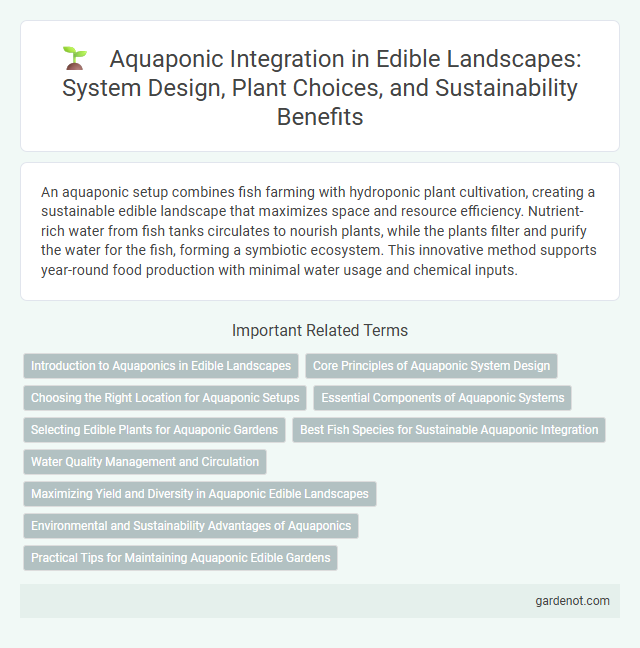An aquaponic setup combines fish farming with hydroponic plant cultivation, creating a sustainable edible landscape that maximizes space and resource efficiency. Nutrient-rich water from fish tanks circulates to nourish plants, while the plants filter and purify the water for the fish, forming a symbiotic ecosystem. This innovative method supports year-round food production with minimal water usage and chemical inputs.
Introduction to Aquaponics in Edible Landscapes
Aquaponics integrates aquaculture and hydroponics to create a symbiotic environment for growing edible plants and raising fish. This sustainable system recycles nutrient-rich water from fish tanks to nourish crops, reducing water usage and eliminating the need for chemical fertilizers. Incorporating aquaponics in edible landscapes enhances food production efficiency while promoting ecological balance and biodiversity.
Core Principles of Aquaponic System Design
Aquaponic system design relies on the core principles of symbiotic balance between aquatic animals and plants, efficient water recirculation, and nutrient cycling. Maintaining optimal environmental conditions such as pH, temperature, and dissolved oxygen is crucial for maximizing fish health and plant growth. System components like biofilters and grow beds must be precisely configured to support continuous nutrient conversion and sustainable food production.
Choosing the Right Location for Aquaponic Setups
Selecting the ideal location for an aquaponic setup involves assessing sunlight exposure, temperature control, and access to clean water sources to optimize plant growth and fish health. A site with consistent natural light, stable temperatures between 65-85degF, and proximity to electricity and water supply ensures efficient system operation and maximizes yield. Proper ventilation and protection from pests further enhance the sustainability and productivity of the edible aquaponic landscape.
Essential Components of Aquaponic Systems
Aquaponic systems integrate fish tanks, grow beds, and a water circulation system as essential components for a sustainable edible landscape. Beneficial bacteria convert fish waste into nutrients, supporting plant growth in the medium-filled or nutrient film technique (NFT) grow beds. High-efficiency water pumps ensure continuous water flow, maintaining oxygen levels critical for both aquatic life and plants.
Selecting Edible Plants for Aquaponic Gardens
Selecting edible plants for aquaponic gardens requires consideration of species that thrive in nutrient-rich water and aquatic environments. Leafy greens such as lettuce, kale, and spinach, along with herbs like basil and mint, are ideal candidates due to their fast growth and high nutrient absorption. Fruiting plants like tomatoes and cucumbers are also suitable but may require additional support and monitoring to optimize yield in aquaponic systems.
Best Fish Species for Sustainable Aquaponic Integration
Tilapia, catfish, and trout are among the best fish species for sustainable aquaponic integration due to their adaptability, fast growth rates, and resilience in controlled environments. Tilapia thrives in warm water and efficiently converts feed into protein, making it ideal for tropical and subtropical edible landscapes. Trout requires cooler water temperatures, suitable for aquaponic systems in temperate regions, while catfish offers hardiness and tolerance to varying water conditions, enhancing system stability and productivity.
Water Quality Management and Circulation
Aquaponic setups require precise water quality management to maintain optimal levels of pH, ammonia, nitrites, and nitrates, ensuring healthy fish and plant growth. Efficient water circulation systems facilitate the continuous exchange of nutrients between fish and plants, promoting oxygenation and waste removal. Monitoring dissolved oxygen and temperature levels is critical to sustaining the delicate balance within the aquaponic ecosystem.
Maximizing Yield and Diversity in Aquaponic Edible Landscapes
Aquaponic setups maximize yield and diversity in edible landscapes by integrating fish farming with hydroponic plant cultivation, creating a symbiotic environment where fish waste provides essential nutrients for plants. Utilizing species like tilapia or trout enhances nutrient cycling, while diverse plant selections such as leafy greens, herbs, and fruiting vegetables optimize space and resource use. Advanced techniques like vertical farming and controlled environment systems further increase productivity, ensuring sustainable, high-yield aquaponic edible landscapes.
Environmental and Sustainability Advantages of Aquaponics
Aquaponic setups combine aquaculture and hydroponics, enabling efficient resource use by recycling water and nutrients, dramatically reducing water consumption by up to 90% compared to traditional agriculture. This closed-loop system minimizes chemical inputs and artificial fertilizers, promoting organic growth and decreasing environmental pollution. Aquaponics supports sustainable food production by lowering carbon footprints and enabling local, year-round crop cultivation with minimal land use.
Practical Tips for Maintaining Aquaponic Edible Gardens
Maintaining an aquaponic edible garden requires regular monitoring of water pH levels, ideally between 6.8 and 7.2, to ensure optimal nutrient availability for plants and fish. Consistent cleaning of the grow beds prevents clogging and promotes healthy root development, while balancing fish feeding schedules avoids ammonia spikes that can harm both plants and aquatic life. Implementing a reliable aeration system enhances oxygen levels, supporting robust plant growth and maintaining a thriving symbiotic environment.
Aquaponic setup Infographic

 gardenot.com
gardenot.com